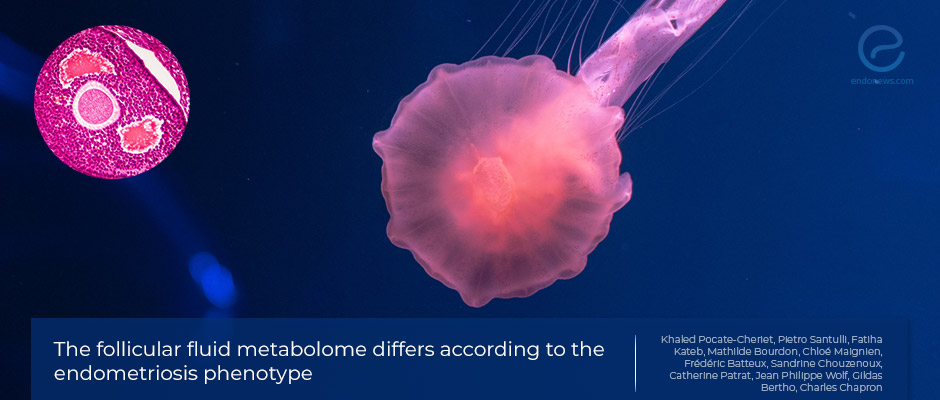The "metabolome" of follicular fluid in deep infiltrating endometriosis
Jan 27, 2021
Could metabolic changes in follicular fluid explain infertility?
Key Points
Highlight:
- This study determines the metabolic element content of the follicular fluid in women with deep infiltrating endometriosis and endometrioma.
Importance:
- The fundamental question is whether follicular fluid-specific metabolic element profile could lead to better understanding and new biomarkers for the diagnosis and prognosis of deep infiltrating endometriosis.
What has been done:
- A prospective cohort study, where fifty follicular fluid samples were collected from women with deep infiltrating endometriosis, with or without an ovarian endometrioma.
- Twenty-nine follicular fluid samples were collected from women with infertility caused by tubal obstruction, which served as controls.
- The metabolite profile of the fluid was analyzed using proton nuclear magnetic resonance (1H-NMR) experiments.
Results:
- The levels of glucose, citrate, creatine, and amino acids (tyrosine and alanine) were lower in endometriosis patients than in controls.
- The levels of lactate, pyruvate, lipids, and ketone bodies were higher in endometriosis patients than in controls.
- Glycerol, ketone bodies, lactate, and pyruvate were increased in patients with endometrioma, whereas glucose was decreased.
- These results suggest a mitochondrial dysregulation in endometriosis that may have affected the fertility of women with endometriosis because the composition of follicular fluid affects oocyte development and the outcome of implantation after fertilization.
Limitation:
- Endometriosis is a heterogeneous condition, the study population had the most severe form of the disease, and hence the data may not be generalizable.
- It is difficult to know whether the control subjects are ideal for comparison of metabolic profiles of follicular fluid.
Lay Summary
Endometriosis encompasses three different phenotypes, being superficial endometriosis, deep infiltrating endometriosis (DIE), and ovarian endometrioma (OMA). The latter is the most severe form and has an unfavorable impact on ovarian function. Infertility associated with endometriosis has been linked to chronic inflammation and oxidative stress in the pelvic cavity. The disease has a negative impact on oocyte quality, which can impair implantation and embryonic development. Currently, the main selection criteria for oocytes and embryos for IVF include morphological aspects, which have limited capacity to predict success.
This study by Pocate-Cheriet et al. at Cochin-Port Royal University Hospital, Paris, France aimed to evaluate the impact of DIE on the metabolic composition (metabolome) of follicular fluid, based on the analysis of follicular fluid from single oocytes following ovarian stimulation. The study also investigated whether the presence of an OMA further affects the fluid composition of the follicular fluid. The results of the study were published in "Reproductive BioMedicine Online". Ultimately, the authors’ goal is to develop new and non-invasive methods that better predict a favorable pregnancy outcome.
The study consisted of 16 women who were infertile and prospectively enrolled in an assisted reproductive technology attempt between March and June 2018. These women were divided into two groups: an endometriosis group and a control group. The endometriosis group had nine women with DIE, some with and some without an OMA. The metabolite composition of the follicular fluid was analyzed using proton nuclear magnetic resonance-based experiments.
The study found that the concentrations of citrate, creatine, and tyrosine and alanine amino acid levels were lower in the follicular fluid of patients with DIE. On the other hand, ketone bodies and glycerol were elevated in women with OMA as compared to participants without OMA and controls. The levels of lactate and pyruvate were also increased, whereas the concentration of glucose was decreased in the patients with OMA. Lactate, pyruvate, and glucose are associated with glycolysis, which is the process that produces an energy source for oocyte growth.
Some amino acids were statistically significant for discriminating between patients with and without OMA groups. These include the concentrations of isoleucine, alanine, glutamine, and tyrosine.
As a whole, these data suggest that DIE uses different energy pathways. DIE without OMA appears to rely on glycolysis, whereas DIE in the presence of OMA appears to rely on other energy pathways, such as the ketone body and glutamine metabolism pathways. Certainly, the results indicate a mitochondrial dysregulation in endometriosis, with alterations in anaerobic glycolysis and beta-oxidation in OMA, which may largely affect fertility. Because the composition of the follicular fluid correlates with oocyte development and implantation outcome, these findings suggest that metabolic changes can help explain the high level of infertility in this subset of endometriosis.
Research Source: https://pubmed.ncbi.nlm.nih.gov/33046374/
pregnancy IVF oxidative stress

